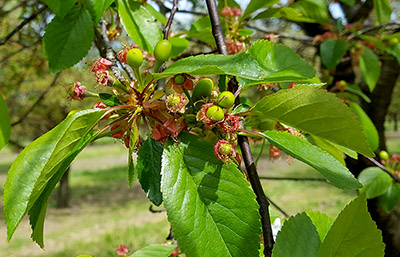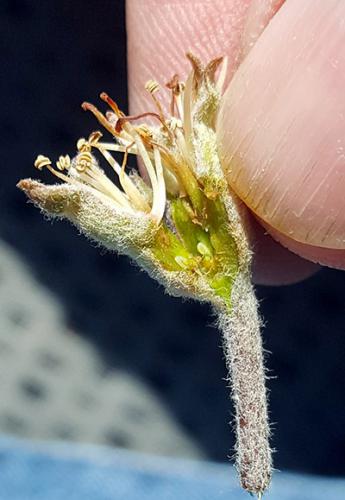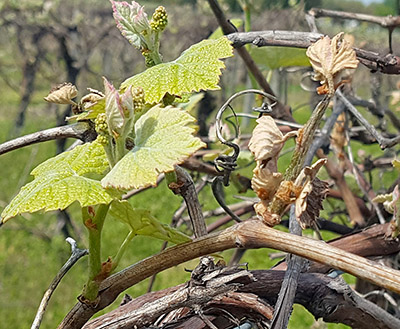Southwest Michigan fruit update – May 16, 2017
The impact of the May 8 freeze is becoming apparent. Some crops were hit hard, other suffered little damage. Warm weather is moving plants and insects rapidly.

Weather
Last week started with a freeze on Monday, May 8. This radiation freeze caused wide spread variable damage. Every freeze is different and this one was no exception. The temperatures were cold enough to cause damage, but not cold enough to damage all crops or cause severe damage across the region. Damage is quite variable depending on the crop and site. Sites that normally escape injury were hurt and other where you would expect severe damage did not suffer as much as expected. Flowers exposed to the sky and on the tops and tips of shoots were hurt more than protected flowers in the interior or those facing down away from the open sky.
The dry air allowed temperatures to drop quickly. Many people are still assessing the damage from this freeze, which was probably the last spring freeze of 2017 in southwest Michigan.
The rest of the week was warm and pleasant. Scattered showers crossed the region Wednesday night, May 10. Thursday through the weekend was warm and windy with high temperatures in the 70s and lows in the 40s. Dry, windy conditions have dried out the top soil, but there are good moisture levels in the subsoil. Soil temperatures are in the 50s and 60s. About 4 inches of rain fell in April with an additional inch in May.
The weather this week should be warmer with highs into the 80s on Tuesday and Wednesday, May 16-17, then falling into the 70s and high 60s over the weekend. The forecast is for warm, windy, unsettled conditions for the week into the weekend. There is a chance of thunderstorms into the weekend.
The cool conditions two weeks ago almost stopped plant and insect development. Warm conditions have moved plants quickly. Many plants that looked weak now appear healthy. The combined effect of this temperature rollercoaster is that we are close to our average normal development for this date.
|
Southwest Michigan GDD summary from Jan. 1– May 14, 2017 | |||
|---|---|---|---|
|
Station |
GDD 42 F |
GDD 45 F |
GDD 50 F |
|
Benton Harbor (SWMRC) |
754 |
579 |
357 |
|
Lawton (Lawton) |
601 |
453 |
268 |
|
Fennville (TNRC) |
537 |
398 |
231 |
|
Average for the southwest region |
635 |
481 |
289 |
|
Average from March 1 |
538 |
414 |
257 |
|
Accumulation last week |
89 |
71 |
45 |
Tree fruit
Warm conditions will bring plum curculio feeding and egglaying in exposed fruit, and growers should apply controls. Rain occurred Wednesday night, May 10, and the wetting period was too short for disease infections except fire blight. The impacts of the May 8 freeze are becoming more apparent in low areas and areas away from Lake Michigan.
Apricots are out of the shuck. The crop is generally light.
Peaches and nectarines are at shuck split or out of the shuck. Peaches in good peach sites did not suffer much from the May 8 freeze, and the crop potential for peaches looks good. Insect activity resumed with warm weather. Based on trap catches at Berrien, Van Buren and Allegan counties, oriental fruit moth biofix ranged from April 21 to 24. Enviroweather’s oriental fruit moth model has insecticides targeting larvae timed for May 10 to 15.
Treatment for tarnished plant bug, plum curculio and rusty spot should begin when fruit emerges from the shuck. Long episodes of wetting and temperatures above 50 degrees Fahrenheit favor bacterial spot. After shuck split, Mycoshield is preferred over copper to suppress bacterial spot.
Sweet cherries are out of the shuck. The largest fruit are about 10 millimeters in diameter and the pits have not begun to harden. Sweet cherries are easily visible on the tree. Damage to sweet cherries from the May 8 freeze is spotty.
Montmorency tart cherries are emerging from the shuck. There are clearly two waves of fruit: the larger, 6- to 8-millimeter fruit emerging from the shuck, and smaller fruit in the shuck. Damage from the May 8 freeze is generally light and spotty. Some orchards report significant damage. The tart cherry crop looks about average for southwest Michigan. Protect against plum curculio as the fruit emerges from the shuck. Cherry leaves are susceptible to cherry leaf spot infection.

Montmorency cherries are emerging from the shuck.
Japanese plum varieties such as Shiro and Vanier are out of the shuck. European plums are coming out of the shuck. Crop loads seem light for European plum in several orchards checked so far. We are in black knot infection season when overwintering knots release spores and infect succulent green twigs of the current season's growth. Use fungicides to protect against black knot infection, which occurs during wet periods with temperatures above 55 F. The period from white bud to shuck split is the most important for control of this disease.
Apple bloom has ended for most varieties. Rapid shoot growth is underway. Some varieties are still blooming on 1-year-old wood. Fruit size diameters range from Gala at 3-5 millimeters, Golden Delicious at 6 millimeters, Red Delicious at 7 millimeters and Zestar at 11 millimeters. Apple fruit set in many sites is light due to poor pollination or damage from the May 8 freeze. Freeze damage in the lower canopy was reported in many apple orchards. A significant fruit drop is underway. The crop should be more apparent as the remaining fruit continue to size.

Cutting this apple fruitlet apart reveals the ovules inside are clear and white, not brown or black that would indicate freezing injury.
Temperatures for this week will be very warm with temperatures in the 80s and 70s. Thinning sprays will be very effective. Growers should assess their crop to determine fruit set and freeze damage. The Cornell University apple carbohydrate model for timing thinning sprays and rates is available in the apple section of Michigan State University Enviroweather.
Scab ascospores trap catches are still significant and expected to continue through May and into early June. Apple scab symptoms from the April 28 to May 2 infection period should appear this week. Protect for apple scab through May. Manage powdery mildew on susceptible varieties until rapid leaf growth ceases. Symptoms from the fire blight infection on April 26 should be visible now. Open bloom during this warm period will be very susceptible to fire blight infection if we have any rain. Showers occurred Monday night and are in the upcoming forecast. Newly planted trees often have delayed bloom that requires fire blight control when rain and warm temperature occur.
Pear fruit range from 9 to 10 millimeters in diameter. Fungicide applications for pear scab are ongoing. Growers should check their trees for fire blight from the April 26 infection periods. We are past bloom so streptomycin should not be used for fire blight unless there is hail or strong winds. Treatments for pear psylla are applied post-bloom and target rapid shoot growth and succulent leaves. Fruit at this stage are particularly sensitive to chemicals and weather conditions that can cause skin russet.
Small fruit
Grape shoots are 3-6 inches long with flower clusters exposed in Concord, Niagara and early hybrid varieties. Later hybrids and vinifera grapes have 1-5 inches of shoot growth with flower clusters exposed on the longer shoots. Many exposed shoots were frozen in in the May 8 freeze. Damage is widespread and varies greatly from one site to another. Both juice grape and wine grapes were injured, though damage is most severe in juice grapes.

Healthy ‘Niagara’ grape shoots (left and center) and damaged shoots (right and background) by the May 8 freeze.
Some vineyards will see no crop reduction; others may see serious crop reduction. Where damage is severe, secondary shoots will grow in a few weeks. These secondary shoots will have flowers on them, but their development will be delayed. This greatly complicates vineyard management with a crop on both primary and secondary shoots.
Juice grapes are past the stage where grape flea beetles and climbing cutworm are a concern, but these pests may still be a concern in varieties with late growth. Protect against shoot infections of phomopsis and leaf infections of black rot. In vulnerable varieties, protection against powdery mildew leaf infections is also occurring. Over the next two weeks, note the beginning of wild grape bloom and record the date it starts to use in the Enviroweather's grape berry moth model.
Blueberry bloom continues. With the warm weather, many fields are approaching full bloom. Effects of the May 8 freeze are readily apparent. The freeze was cold enough to cause injury to open bloom, but not cold enough to kill less developed flowers. Overhead sprinkler systems seemed to provide good protection. Damage in unprotected fields depends on the site, stage of development and the actual low temperature. The freeze mainly damaged only open flowers and damage to the petals of open flowers was readily visible. Only flowers at the tips of the shoots were open and damaged. Damage to pistils and styles inside these flowers is spotty.
Bloom has progressed rapidly since the freeze and bees seem to be working hard in the field. This freeze will not have a significant impact on Michigan blueberry production since only a small portion of the bloom was lost. Some growers applied gibberellic acid products to save damaged bloom. In flowers where the ovules (that will become the seeds) were damaged, this is unlikely to save these dead fruit. This treatment is likely to help where the style was damaged but the pistil and ovules were not.
Mummy shoot strikes are appearing. Apply fungicides to protect against mummy berry in the fruit if shoot strikes are appearing in your fields. Research indicates that fungicides can harm the health of beehives. Use caution when applying fungicides during bloom. Avoid spraying during the day when bees are foraging. Plan your mummy berry control strategies rather than reacting to conditions. Fungicides for mummy berry control are recommended at early and mid-bloom.
Cherry fruitworm adults were caught during the warm weather before the freeze. The cold weather shut down trap catch. Trap for fruitworm in your fields so you can set the biofix. We expect a strong flight with this warm weather. Use the cherry fruitworm and cranberry fruitworm models on Enviroweather to target their controls.
Strawberry flower trusses are emerging the crown. Bloom has begun in some fields. Most growers have been using sprinklers to protect their crop. Once strawberry flower buds are above the ground, they can be hurt by temperatures in the 20s. Have sprinklers setup for freeze protection since the flower buds are vulnerable to freeze injury.
Bramble leaves have unfolded on the floricanes. Primocanes are about 6 inches high. Michigan State University Extension advises scouting for orange rust; spray to reduce its spread should be applied now.
Upcoming meetings
Our next Monday fruit IPM meeting is Monday, May 22, at Fruit Acres Farms, 3452 Friday Rd in Coloma, Michigan, at 5 p.m. Two Michigan RUP applicator recertification credits are available at these meetings.
See also
- Southwest Michigan fruit update – May 9, 2017
- Assessing frost and freeze damage to flowers and buds of fruit trees
- Effectively controlling plum curculio in stone and pome fruits
- Management of bacterial spot on peaches and nectarines
- Time to buckle down rather than give up on controlling oriental fruit moth in peaches
- Controlling black knot in Michigan
- How to use Enviro-weather’s apple scab tool
- What to do with current apple powdery mildew infection
- SDHI fungicides for apple scab management
- Use Precision Cropload Management tools to target apple crop load
- Many materials available for pear psylla management
- Pest management in frost-damaged vineyards
- What to do in a vineyard with early season crop loss
- Gibberellin to increase blueberry fruit set
- Protect against blossom blights in blueberries
- New cherry fruitworm tool for IPM in blueberries
- Trapping for fruitworm pests as part of your blueberry IPM program



 Print
Print Email
Email


